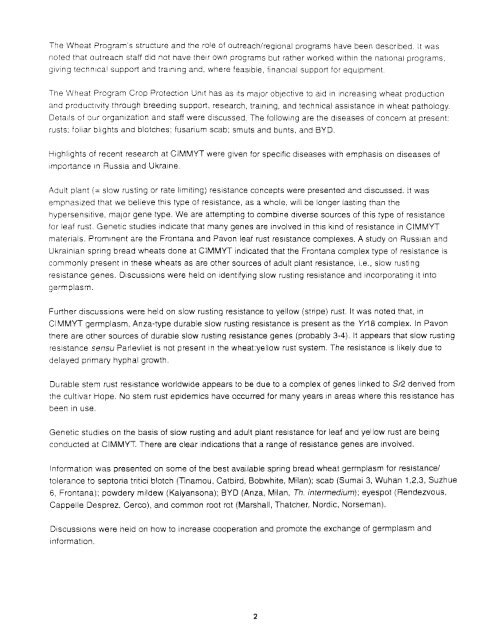Untitled - Search CIMMYT repository
Untitled - Search CIMMYT repository
Untitled - Search CIMMYT repository
Create successful ePaper yourself
Turn your PDF publications into a flip-book with our unique Google optimized e-Paper software.
The Wheat Program's structure and the role of outreach/regional programs have been described. It wasnoted that outreach staff did not have their own programs but rather worked within the national programs,giving technical support and training and, where feasible, financial support for equipment.The Wheat Program Crop Protection Unit has as its major objective to aid in increasing wheat productionand productivity through breeding support, research, training, and technical assistance in wheat pathology.Details of our organization and staff were discussed. The following are the diseases of concern at present:rusts; foliar blights and blotches; fusarium scab; smuts and bunts, and BYD.Highlights of recent research at <strong>CIMMYT</strong> were given for specific diseases with emphasis on diseases ofimportance In Russia and Ukraine.Adult plant (= slow rusting or rate limiting) resistance concepts were presented and discussed. It wasemphasized that we believe this type of resistance, as a whole, will be longer lasting than thehypersensitive, major gene type. We are attempting to combine diverse sources of this type of resistancefor leaf rust. Genetic studies indicate that many genes are involved in this kind of resistance in <strong>CIMMYT</strong>materials. Prominent are the Frontana and Pavon leaf rust resistance complexes. A study on RUSSian andUkrainian spring bread wheats done at <strong>CIMMYT</strong> indicated that the Frontana complex type of resistance iscommonly present in these wheats as are other sources of adult plant resistance, i.e., slow rustingresistance genes. Discussions were held on identifying slow rusting resistance and incorporating it intogermplasm.Further discussions were held on slow rusting resistance to yellow (stripe) rust. It was noted that, in<strong>CIMMYT</strong> germplasm, Anza-type durable slow rusting resistance is present as the Yr18 complex. In Pavonthere are other sources of durable slow rusting resistance genes (probably 3-4). It appears that slow rustingresistance sensu Parlevliet is not present in the wheat:yellow rust system. The resistance is likely due todelayed primary hyphal growth.Durable stem rust resistance worldwide appears to be due to a complex of genes linked to Sr2 derived fromthe cultivar Hope. No stem rust epidemics have occurred for many years in areas where this resistance hasbeen in use.Genetic studies on the basis of slow rusting and adult plant resistance for leaf and yellow rust are beingconducted at <strong>CIMMYT</strong>. There are clear indications that a range of resistance genes are involved.Information was presented on some of the best available spring bread wheat germplasm for resistance/tolerance to septaria tritici blotch (Tinamou, Catbird, Bobwhite, Milan); scab (Sumai 3, Wuhan 1,2,3, Suzhue6, Frontana); powdery mildew (Kalyansona); BYD (Anza, Milan, Th. intermedium); eyespot (Rendezvous,Cappel Ie Desprez. Cerco), and common root rot (Marshall, Thatcher, Nordic, Norseman).Discussions were held on how to increase cooperation and promote the exchange of germplasm andinformation.2

















